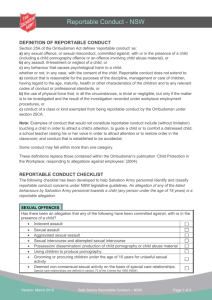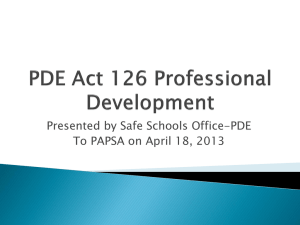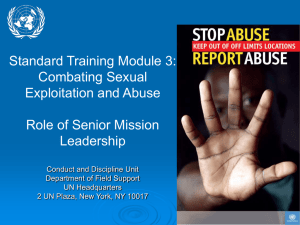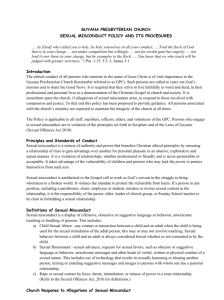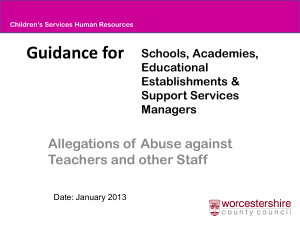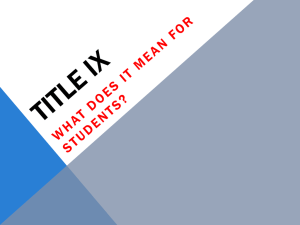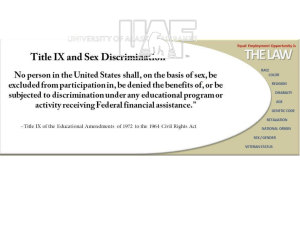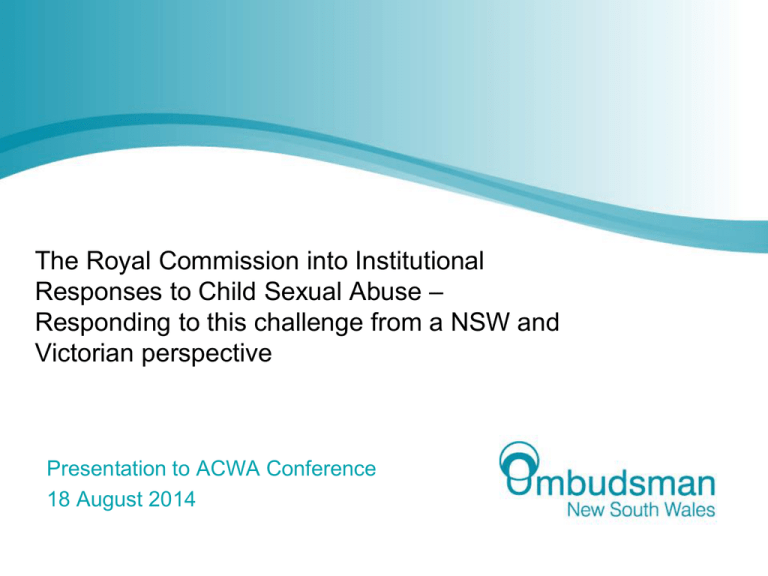
The Royal Commission into Institutional
Responses to Child Sexual Abuse –
Responding to this challenge from a NSW and
Victorian perspective
Presentation to ACWA Conference
18 August 2014
Background
Our Part 3A jurisdiction involves overseeing the
handling of child abuse and neglect allegations that
are made against employees of more than 7,000
government and non-government agencies.
The Ombudsman oversees how agencies
investigate and respond to reportable allegations,
and scrutinises the systems which agencies have in
place for identifying and responding to this conduct.
Reportable conduct includes:
• sexual offences and sexual misconduct involving
a child
• physical assault of a child
• neglect and ill-treatment of a child, and
• behaviour causing psychological harm to a child
The allegation based system which triggers a
notification under Part 3A of the Ombudsman Act
complements the WWCC system.
Under section 35 of the Working with Children Act,
prescribed reporting bodies are required to notify the
Children’s Guardian of findings of misconduct in
relation to:
1. Sexual misconduct committed against, with or in
the presence of a child, including grooming of a
child.
2. Any serious physical assault of a child.
Schedule 1, Clause 2A of the Act, enables the
Ombudsman to make a ‘notification of concern’ to
the Children’s Guardian if we form the view, as a
result of concerns arising from the receipt of
information by our office in the course of exercising
our functions, that ‘on a risk assessment by the
Children’s Guardian, the Children’s Guardian may
be satisfied that the person poses a risk to the safety
of children’.
Both section 35 referrals and Schedule 1, Clause 2A
referrals by our office trigger a ‘risk assessment’ by
the Children’s Guardian in relation to whether the
involved individuals pose a risk to children.
The need to accept change
• our initial focus was on strengthening systems, rather than
responding to risks associated with individual cases;
• our limited active engagement with agencies reporting
matters to us;
• insufficient communication and collaboration with Police
and other key agencies;
• insufficient critical analysis in relation to certain highly
significant pieces of information;
• a lack of clarify as to when issues required escalation to
statutory officer level;
• a restricted definition of ‘sexual misconduct’ which made it
difficult, at the time, to find reportable conduct even in
cases of significant concern; and
• insufficient emphasis on the need for alleged victims to be
informed about the action or inaction of agencies
responding to allegations of sexual abuse.
Implementing change
• repositioning our strategic focus towards more active
monitoring of higher-risk, more serious allegations;
• increasing the proportion of investigators at a senior level
in our Employment Related Child Protection Division;
• increasing the level of practical support to agencies,
particularly in relation to allegations of serious reportable
conduct; and
• structural changes to our Employment Related Child
Protection workforce.
Current Snapshot
• Open notification by primary allegation type
Allegation
Sexual Offence
Sexual Misconduct
Physical Assault
Psych Harm
Neglect
Ill –treatment
Total
206
348
263
10
234
61
Total 1122
• Open notifications with significant features
Notifications With:
Criminal Charges
Total
9% (110)
Notification of Concerns/ Ch16As 12% (139)
to OCG
Total 21% (249)
Comparison of Notifications between Education
and OOHC (closed 2013-2014)
Allegation
Sexual Offence
DEC
19.1% (59)
OOHC
6% (28)
Sexual Misconduct
52.8% (163)
14% (63)
Physical Assault
8.1% (25)
45% (205)
Psych Harm
2.7% (7)
0.20% (1)
Neglect
9.7% (30)
26% (122)
Ill Treat
4% (14)
7% (33)
Not in Jurisdiction
3.6% (11)
1.8% (8)
100% (309)
100% (457)
Total
Comparison of Sustained Findings between
Education and OOHC
DEC
OOHC
Sexual Offence
44%
21%
Sexual Misconduct
18%
14%
Physical Assault
9%
20%
Allegation Type
Identifying the need for systemic change in
areas of child practice
• Improving interagency cooperation to ensure effective
management of child sex offenders in the community
• Improving the handling of historical allegations of child
sexual abuse
• Improving the reporting of allegations of serious criminal
child abuse to police
• Ensuring that the safety, welfare and wellbeing of children
takes precedence over an individual's privacy
• Highlighting the need for law reform in relation to interstate
information exchange
• Failure to appropriately assess and manage risks to
children in OOHC placements where there have been
allegations of sexual abuse
• Multiple CNI profiles leading to individuals not being
picked up as having previous offending histories and/or
disturbing intelligence reports
• Data recording deficiencies in Community Services’ KiDS
database and related searching practices
• The need to utilise police intelligence holdings to help
protect children
• The need to improve carer screening/assessments and
related risk management processes
• Chronic delays in Community Service’s Reportable
Conduct Unit
• Practice weaknesses in the operations of the JIRT
(including the Child Abuse Squad)
Contact details
Steve Kinmond
Deputy Ombudsman, and Disability and Community
Services Commissioner
NSW Ombudsman
Ph: (02) 9286 0987
E: skinmond@ombo.nsw.gov.au

